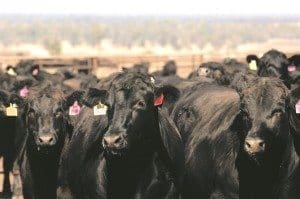AUSTRALIA’s livestock sector is one of the lowest users of antimicrobials in the world, an enviable position which the feedlot industry is determined to reinforce through the upcoming launch of a new stewardship program.
In what is believed to be a first for the lotfeeding sector anywhere in the world, the Australian grainfed industry will have its own Antimicrobial Stewardship Framework to help guide judicious use of antimicrobials – minimising resistance while achieving high levels of animal health.
It is the first outcome of a two-year project funded jointly by grainfed producer levies and the Australian Government in consultation with the Australian Lot Feeders Association, as part of the National Feedlot Animal Health Management Program that started a yeat ago.

Meat & Livestock Australia has engaged antimicrobial stewardship expert Dr Stephen Page and several leading feedlot vets including Drs Kev Sullivan, Paul Cusack and David Frith and veterinary microbiologist Professor Darren Trott to develop the framework.
Antimicrobial Stewardship (AMS) seeks to preserve antimicrobials by encouraging investigation of ways of avoiding their use. If they must be used, AMS provides a framework to sustain the clinical efficacy of antimicrobials by optimising drug choice, use, dosage, duration, and route of administration, while minimising the emergence of resistance and other adverse effects.
Veterinarian and clinical pharmacologist, Dr Stephen Page from Advanced Veterinary Therapeutics, said Australia was one of the world leaders in judicious use of antimicrobials in agriculture, with only a handful of countries including Sweden, Norway and Iceland using comparatively less.
Dr Page said the release of the AMS framework for the Australian feedlot industry would provide guidance to the industry and facilitate the critical review of antimicrobial use on a feedlot-by-feedlot basis and later provide the advantages of an industry benchmark.
“The benefit to each feedlot is that for the first time, they will be able to assess if their current use of antibiotics meets standards of appropriate use and how they may be able to increase the quality of use,” Dr Page said.
“We’re not using a lot of antimicrobials compared to the rest of the world, but we’re not complacent, we think we can increase the quality of current use even further. We want consumers to be reassured and know that any use is being thoroughly thought out and meets or exceeds the highest standards of best practice.”
“If you can get zero use, that’s fantastic, but that shouldn’t be the goal. The target should be to maintain the highest standards of health and welfare of the animal and wherever possible, reduce risks to public health, which are already likely to be extremely low.
“AMS doesn’t promise a financial return, but in theory, if this process identifies opportunities to reduce disease risk and improve antibiotic use, then there would be potentially less antibiotic cost, as reducing the risks of various infectious diseases will achieve better health outcomes.”
‘5R’ framework
The 5R AMS framework is based on the continuous improvement cycle of Review, Reduce, Refine and Replace, with the fifth ‘R’ Responsibility reflecting the full support of all stakeholders. It prompts feedlots to examine guidelines, pre-treatment principles, diagnosis, drug selection and use, and monitor post-treatment responses.
“That doesn’t mean introducing the AMS framework is going to be onerous, because much of what it sets out is already well established practice in the feedlot industry,” Dr Page said.
“The industry has been working to progressively reduce the risk factors for infections and increase the ability of animals to fend off disease by implementing health programmes which include vaccination, good biosecurity, nutrition and management practices combined to improve animal health and reduce antimicrobial use.”
Australia already adheres to stringent controls around antimicrobial use in food animals. Under the National Feedlot Accreditation Scheme, antimicrobials must be administered by trained personnel and their use recorded.



HAVE YOUR SAY